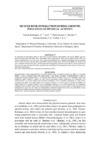Please use this identifier to cite or link to this item:
https://accedacris.ulpgc.es/handle/10553/57437
| Title: | Muscle bone-interaction during growth: influence of physical activity | Authors: | Vicente Rodriguez, Germán Ara Royo, Ignacio Pérez-Gómez, J Dorado García, Cecilia Serrano Sánchez, José Antonio López Calbet, José Antonio |
UNESCO Clasification: | 241106 Fisiología del ejercicio | Keywords: | salud del esqueleto composición corporal desarrollo ejercicio Skeletal health, et al |
Issue Date: | 2006 | Journal: | European Journal of Human Movement | Abstract: | Para determinar el efecto independiente de los tejidos blandos sobre el contenido mineral óseo (BMC) y la densidad (BMD), y como la actividad física (PA) podría afectar a ésta relación, evaluamos longitudinalmente (3 años) la composición corporal mediante DXA, y la condición física (PF) en 26 niños activos y 16 sedentarios, todos ellos prepúberes cuando comenzó el estudio. Los niños activos presentaban ventajas significativas en el desarrollo de la condición física y de la masa magra (masa muscular) comparados con los sedentarios. Igualmente, los niños activos acumularon más BMC en la región lumbar de la columna vertebral y en el total corporal y también más BMD en la región lumbar de la columna vertebral, en las extremidades inferiores y en el total corporal que sus compañeros sedentarios. Estos resultados sugieren que durante la pubertad, el desarrollo de la masa magra es el mejor predictor de la acumulación de masa ósea. Así mismo, la actividad física estimula la adquisición de masa ósea aumentando la masa muscular pero también mediante mecanismos independientes de la masa magra. To determine the independent effect of soft tissues on bone mineral content (BMC) and density (BMD), and how physical activity (PA) could affect these relationships, body composition by DXA, and the physical fitness (PF) were assessed longitudinally (3-yr) in 26 active and 16 non-active prepubertal boys. Significant advantage in the development of PF, muscle mass and total and lumbar spine BMC and total, lumbar spine and lower-limb BMD were found in the active compared with non-active boys. Results imply that during puberty, lean mass development is the best predictor of bone mass accrual; and physical activity promotes bone acquisition by increasing lean mass but also by lean mass-independent mechanisms. |
URI: | https://accedacris.ulpgc.es/handle/10553/57437 | ISSN: | 0214-0071 | Source: | European Journal Of Human Movement [ISSN 2386-4095], v. 15, p. 23-35, 2006 | URL: | http://dialnet.unirioja.es/servlet/articulo?codigo=2279191 |
| Appears in Collections: | Artículos |
Items in accedaCRIS are protected by copyright, with all rights reserved, unless otherwise indicated.
